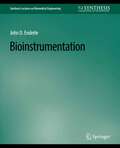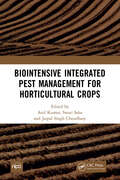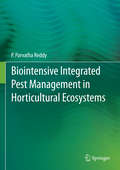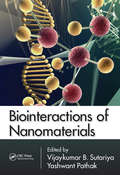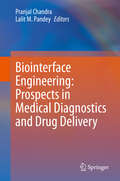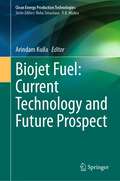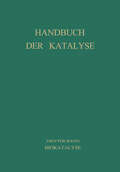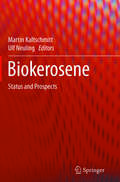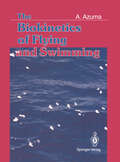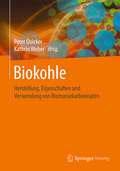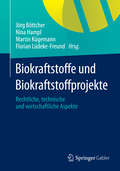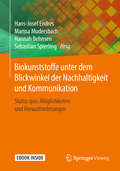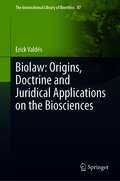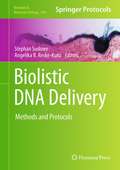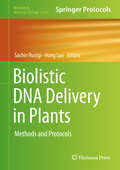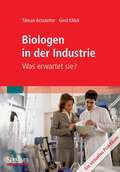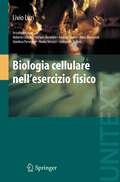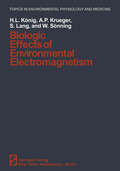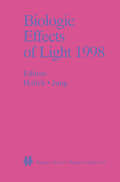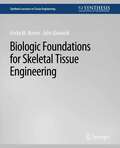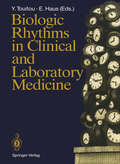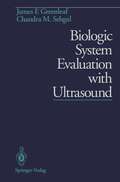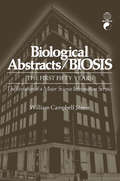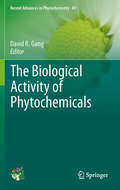- Table View
- List View
Bioinstrumentation (Synthesis Lectures on Biomedical Engineering)
by John EnderleThis short book provides basic information about bioinstrumentation and electric circuit theory. Many biomedical instruments use a transducer or sensor to convert a signal created by the body into an electric signal. Our goal here is to develop expertise in electric circuit theory applied to bioinstrumentation. We begin with a description of variables used in circuit theory, charge, current, voltage, power and energy. Next, Kirchhoff's current and voltage laws are introduced, followed by resistance, simplifications of resistive circuits and voltage and current calculations. Circuit analysis techniques are then presented, followed by inductance and capacitance, and solutions of circuits using the differential equation method. Finally, the operational amplifier and time varying signals are introduced. This lecture is written for a student or researcher or engineer who has completed the first two years of an engineering program (i.e., 3 semesters of calculus and differential equations). A considerable effort has been made to develop the theory in a logical manner—developing special mathematical skills as needed. At the end of the short book is a wide selection of problems, ranging from simple to complex.
Biointensive Integrated Pest Management for Horticultural Crops
by Anil KumarThe book has covered recent techniques on bio-intensive integrated approaches of horticultural pest’s management. An attempt to compile information on non-chemical ways of pest management strategies including agronomic approaches to physical, mechanical, biopesticides, biocontrol agents, biorational pesticides etc. which are non harmful to environment and economically viable has been made. This book is a useful reference material for organic product producing farmers, researchers and students who are involved in bio-intensive pest management strategies.Note: T& F does not sell or distribute the hardback in India, Pakistan, Nepal, Bhutan, Bangladesh and Sri Lanka. This title is co-published with NIPA.
Biointensive Integrated Pest Management for Horticultural Crops
by Anil Kumar Swati Saha Jaipal Singh ChoudharyThe book has covered recent techniques on bio-intensive integrated approaches of horticultural pest’s management. An attempt to compile information on non-chemical ways of pest management strategies including agronomic approaches to physical, mechanical, biopesticides, biocontrol agents, biorational pesticides etc. which are non harmful to environment and economically viable has been made. This book is a useful reference material for organic product producing farmers, researchers and students who are involved in bio-intensive pest management strategies.Note: T& F does not sell or distribute the hardback in India, Pakistan, Nepal, Bhutan, Bangladesh and Sri Lanka. This title is co-published with NIPA.
Biointensive Integrated Pest Management in Horticultural Ecosystems
by P. Parvatha ReddyThrough ‘Green Revolution’ in late 1960s, India achieved self-sufficiency in food production, but still the country has not achieved self-sufficiency in production of horticultural crops. Most of the growth in food production during the green revolution period is attributed to the use of higher levels of fertilizers and pesticides which are continuing to destroy stable traditional ecosystems. The challenge before the crop protection scientist is to increase yields from the existing land without harming the environment and resource base. This can be achieved by adopting eco-friendly Biointensive Integrated Pest Management (BIPM) strategy.BIPM incorporates ecological and economic factors into agricultural system design and decision making, and addresses public concerns about environmental quality and food safety. The benefits of implementing BIPM can include reduced chemical input costs, reduced on-farm and off-farm environmental impacts, and more effective and sustainable pest management. An ecology-based IPM has the potential of decreasing inputs of fuel, machinery, and synthetic chemicals-all of which are energy intensive and increasingly costly in terms of financial and environmental impact. Such reductions will benefit the grower and society.The present book deals with the most recent biointensive integrated approaches for pest management utilizing components such as bioagents [predators, parasitoids and pathogens (bacteria, fungi, viruses)], botanicals (biofumigation, oil cakes, FYM, compost, crop residues, green manuring and other organic amendments), arbuscular mycorrhizal fungi, physical methods (hot water treatment of planting material, soil solarization), cultural methods (crop rotation, summer ploughing, fallowing, intercropping, pruning, mulching, spacing, planting date, trap cropping, etc.), biorational chemicals (pheromones) and resistant cultivars. This book can serve as a useful reference to policy makers, research and extension workers, practicing farmers and students. The material can also be used for teaching post-graduate courses.
Biointeractions of Nanomaterials
by Vijaykumar B. Sutariya Yashwant PathakAn examination of the widespread application of nano materials in biology, medicine, and pharmaceuticals and the accompanying safety concerns, Bio-interactions of Nano Materials addresses the issues related to toxicity and safety of nano materials and nano systems. It covers the interactions in biological systems and presents various tools and meth
Biointerface Engineering: Prospects in Medical Diagnostics and Drug Delivery
by Pranjal Chandra Lalit M. PandeyThis book provides detailed information on the surface and surface chemistry of various biointerfaces for the understanding and development of biosensors, biocompatible devices, and drug delivery systems. It highlights the role of interfacial phenomena towards the behaviour of biomolecules on different surfaces and their significance in recent applications. The book also addresses various surface engineering techniques for the modification of biomaterials that are implemented for improving biocompatibility. It provides an updated scientific concept of various interactions of biological systems with surfaces/modified surfaces at the molecular and cellular level. The chapters include various in-vitro, in-vivo, ex-vivo models to illustrate various aspects of Biointerface Engineering. Finally, the book elucidates troubleshooting strategies and future prospects of Biointerface Engineering in Medical Diagnostics and Drug Delivery.
Biojet Fuel: Current Technology and Future Prospect (Clean Energy Production Technologies)
by Arindam KuilaThis book covers the basic knowledge of biojet fuel, explores the current technological status, and presents future prospects for commercial biojet fuel production. The focus of this book is on biojet fuel production from different types of potential substrates. It also includes technoeconomic analysis and life cycle assessment of biojet fuel. Biojet fuel is currently recognized as the best alternative to petroleum-based jet fuel due to its renewability and sustainable features. However, there is a scarcity of reports on biojet fuel production from various types of substrates.The aviation industry globally consumes approximately 200 million tonnes of jet fuels each year, with a projected continuous growth rate of 5% per year until 2050 (Seymour et al., 2020). Currently, the global demand for jet fuel is predominantly met by petroleum-based fuels. However, the limited availability of fossil fuels and increasing concerns about climate change have placed significant pressure on commercial airlines to reduce greenhouse gas emissions and embrace cleaner and more sustainable practices.Biojet fuel has emerged as the most favorable alternative to petroleum-based jet fuel due to its renewable nature and sustainable characteristics. Despite its potential, there is a limited number of reports available on the production of biojet fuel from different types of substrates. The present scenario of biojet fuel necessitates the development of improved and cost-effective technologies that can yield long-term benefits.The book is useful for students and researchers in various branches of life sciences, including environmental biotechnology, bioprocess engineering, renewable energy, chemical engineering, nanotechnology, biotechnology, microbiology, and more.
Biokatalyse
by G. M. SchwabDieser Buchtitel ist Teil des Digitalisierungsprojekts Springer Book Archives mit Publikationen, die seit den Anfängen des Verlags von 1842 erschienen sind. Der Verlag stellt mit diesem Archiv Quellen für die historische wie auch die disziplingeschichtliche Forschung zur Verfügung, die jeweils im historischen Kontext betrachtet werden müssen. Dieser Titel erschien in der Zeit vor 1945 und wird daher in seiner zeittypischen politisch-ideologischen Ausrichtung vom Verlag nicht beworben.
Biokerosene: Status and Prospects
by Martin Kaltschmitt Ulf NeulingThis book provides a detailed overview of aspects related to the overall provision chain for biokerosene as part of the global civil aviation business. Starting with a review of the current market situation for aviation fuels and airplanes and their demands, it then presents in-depth descriptions of classical and especially new types of non-edible biomass feedstock suitable for biokerosene provision. Subsequent chapters discuss those fuel provision processes that are already available and those still under development based on various biomass feedstock materials, and present e.g. an overview of the current state of the art in the production of a liquid biomass-based fuel fulfilling the specifications for kerosene. Further, given the growing interest of the aviation industry and airlines in biofuels for aviation, the experiences of an air-carrier are presented. In closing, the book provides a market outlook for biokerosene. Addressing a broad range of aspects related to the pros and cons of biokerosene as a renewable fuel for aviation, the book offers a unique resource.
The Biokinetics of Flying and Swimming
by Akira AzumaFrom a mechanical perspective, an animal's shape and the topological connection of its organs are important factors in locomotion. This book describes the physical relationships between form, habitat, way of life, and movement in living creatures. It includes in-depth mechanical and mathematical analyses of the way in which creatures move about, and it also investigates dispersal modes of plants and animals within the framework of flying and swimming. The book is written from the viewpoint of mechanics, specifically fluid dynamics and flight dynamics, rather than from that of physiology and ecology. It will prove a useful reference for aeronautical and mechanical engineers as well as for biologists who use mechanical analyses in the study of behaviour, function, and locomotion.
Biokohle: Herstellung, Eigenschaften und Verwendung von Biomassekarbonisaten
by Dennis Blöhse Thomas Echterhof Sabrina Eichenauer Simone Heger Claudia Kammann Andrea Kruse Peter Quicker Marc-André Schulten Christoph Sager Saulo Seabra Klaus Serfass Ernst Stadlbauer Kathrin WeberBiomassekarbonisate (Biokohlen) besitzen signifikant unterschiedliche Eigenschaften, die von den Herstellungsverfahren, Prozessbedingungen und Ausgangssubstraten abhängen. Im Buch sind die technisch verfügbaren Verfahren zur Erzeugung von Biokohle beschrieben und die thermochemischen Prozesse erörtert. Anhand von zahlreichen farbigen Abbildungen sind die Prozesse, Eigenschaften und Einsatzmöglichkeiten veranschaulicht. Der Fokus des Buches liegt auf den großtechnischen Anwendungen als Energieträger, als Reduktions- oder Aufkohlungsmittel in metallurgischen Verfahren, in Recyclingprozessen oder in Kraft- und Zementwerken. Aber auch die Anwendung von Biomassekarbonisaten in der Landwirtschaft als Bodenhilfsstoff oder in der Tierhaltung ist aufgezeigt.
Biokraftstoffe und Biokraftstoffprojekte: Rechtliche, technische und wirtschaftliche Aspekte
by Jörg Böttcher Nina Hampl Martin Kügemann Florian Lüdeke-FreundDieses Buch beschäftigt sich mit Biokraftstoffen und Biokraftstoffprojekten. Die Autoren zeigen auf, welche rechtlichen, agrarischen, ökologischen und ökonomischen Rahmenbedingungen von Biokraftstoffen beachtet werden müssen. Die Betrachtung dieser Rahmenbedingungen und weiterer – eher anlagenbezogener – Faktoren ermöglicht es dann, Rückschlüsse auf die Realisierung von Biokraftstoffvorhaben zu ziehen. Besonderes Augenmerk wird dabei auf den sensiblen Themenkomplex der Nachhaltigkeit von Biokraftstoffen gerichtet. Die anhaltende Diskussion unerwünschter sozialer, ökologischer und ökonomischer Effekte hat zu neuen und bislang nicht abschließend definierten gesellschaftlichen und politischen Ansprüchen an die Biokraftstoffindustrie geführt.
Biokunststoffe unter dem Blickwinkel der Nachhaltigkeit und Kommunikation: Status quo, Möglichkeiten und Herausforderungen
by Hans-Josef Endres Marina Mudersbach Hannah Behnsen Sebastian SpierlingDas Buch zeigt, wie eine Nachhaltigkeitsbewertung von Biokunststoffen gelingen kann und wie die Ergebnisse einer solchen Bewertung ausfallen. Es analysiert die öffentliche Wahrnehmung beim Verbraucher sowie die politischen Rahmenbedingungen von Biokunststoffen.
Biolaw: Origins, Doctrine and Juridical Applications on the Biosciences (The International Library of Bioethics #87)
by Erick ValdésThis book configures a consistent epistemology of biolaw that distinguishes itself from bioethics and from a mere set of international instruments on the regulation of biomedical practices. Such orthodox intellection has prevented biolaw from being understood as a new branch of law with legally binding force, which has certainly dwindled its epistemological density. Hence, this is a revolutionary book as it seeks to deconstruct the history of biolaw and its oblique epistemologies, which means not accepting perennial axioms, and not seeing paradigms where only anachronism and anomaly still exist. It is a book aimed at validity, but also at solidity because the truth of biolaw has never been told before. In that sense, it is also a revealing text. The book shapes biolaw as an independent and compelling branch of law, with a legally binding scope, which boosts the effectiveness of new deliberative models for legal sciences, as well as it utterly reinforces hermeneutical and epistemological approaches, in tune with the complexity of disturbing legal scenarios created by biomedical sciences’ latest applications. This work adeptly addresses the origins of the European biolaw and its connections with American bioethics. It also analyses different biolaw’s epistemologies historically developed both in Europe and in the United States, to finally offer a new conception of biolaw as a new branch of law, by exploring its theoretical and practical atmospheres to avoid muddle and uncertainty when applied in biomedical settings. This book is suitable for academics and students of biolaw, law, bioethics, and biomedical research, as well as for professionals in higher education institutions, courts, the biomedical industry, and pharmacological companies.
Biolistic DNA Delivery: Methods and Protocols (Methods in Molecular Biology #940)
by Stephan Sudowe and Angelika B. Reske-KunzBiolistic transfection represents a direct physical gene transfer approach in which nucleic acids are precipitated on biologically inert high-density microparticles (usually gold or tungsten) and delivered directly through cell walls and/or membranes into the nucleus of target cells by high-velocity acceleration using a ballistic device such as the gene gun. Biolistic DNA Delivery: Methods and Protocols provides a comprehensive collection of detailed protocols intended to provide the definitive practical guide for the novice as well as for the advanced gene transfer expert on how to introduce nucleic acids into eukaryotic cells using the biolistic technique. Split into six convenient sections, this detailed volume covers biolistic gene transfer into plants, nematodes, and mammalian cells, both in vitro and in vivo, as well as the use of gene gun-mediated DNA vaccination in various experimental animal models of human diseases, and the description of biolistic delivery of molecules other than nucleic acids. Written in the highly successful Methods in Molecular Biology™ series format, chapters include introductions to their respective topics, lists of the necessary materials and reagents, step-by-step, readily reproducible laboratory protocols, and tips on troubleshooting and avoiding known pitfalls. All-inclusive and cutting-edge, Biolistic DNA Delivery: Methods and Protocols brings together the knowledge and the experience of leading experts in the field of gene transfer in order to serve all researchers who wish to further our abilities in this vital field.
Biolistic DNA Delivery in Plants: Methods and Protocols (Methods in Molecular Biology #2124)
by Hong Luo Sachin RustgiThis volume details protocols for the use of the biolistic DNA delivery method in different plant species. Chapters guide readers through non-protocol chapters that cover relevant topics of interest, a broad overview of the field, exciting modifications of the system, and reliable plant transformation procedures in different plant species. Written in the highly successful Methods in Molecular Biology series format, chapters include introductions to their respective topics, lists of the necessary materials and reagents, step-by-step, readily reproducible laboratory protocols, and tips on troubleshooting and avoiding known pitfalls. Authoritative and cutting-edge, Biolistic DNA Delivery: Methods and Protocols aims to provide a comprehensive collection of protocols to intended to be a practical guide for the novice as well as the advanced user in the field of plant genetic transformation.
Biologen in der Industrie: Ein virtuelles Praktikum
by Tilman Achstetter Gerd KlöckDer Weg in die Grundlagenforschung steht nur wenigen Absolventen von Biologiestudiengängen offen. Die meisten Biologen orientieren sich daher in der Wirtschaft. Die Autoren zeigen in diesem Buch in Form eines virtuellen Praktikums in der fiktiven Firma „TiGer BioTec" auf, welche Aufgaben Biologen, aber auch andere Naturwissenschaftler in der freien Wirtschaft erwarten können. Das Buch veranschaulicht in einem Planspiel mit Praxisbeispielen und Übungsaufgaben Aspekte der Marktrecherche, Informationsbeschaffung, sowie der Produktentwicklung, und gibt einen Einblick in die Bedeutung von Projektmanagement und Qualitätssicherung. Das Buch wendet sich an Biologen und andere Naturwissenschaftler, die eine Alternative zur Tätigkeit in der Grundlagenforschung suchen. Es ist eine wertvolle Orientierungshilfe für Lehrer wie Schüler von Gymnasien, Fachschulen, und Berufsakademien, welche sich ein praxisnahes Bild vom Beruf des Naturwissenschaftlers machen wollen.
Biologia cellulare nell'esercizio fisico
by Livio LuziLa nascita delle Facoltà e dei Corsi di Laurea di Scienze Motorie, e la chiusura degli ISEF, hanno prodotto un radicale mutamento degli insegnamenti della nuova Facoltà Universitaria. In particolare, i percorsi di formazione degli insegnamenti forniti da Scienze Motorie, a seguito delle due riforme che si sono succedute nell’ultimo decennio, si sono notevolmente arricchiti di materie teoriche sia di base che applicate a problematiche del movimento umano. La Biologia Applicata è sicuramente tra i nuovi insegnamenti quello che più di altri caratterizza la differenza tra i corsi ISEF e le nuove classi di Laurea universitarie inerenti lo sport. A questo riguardo, esisteva quindi una lacuna formativa e comunicativa nel campo della Biologia Applicata che andava colmata con la preparazione di questo manuale che, senza la pretesa di essere esaustivo nel settore della Biologia, tratta in dettaglio gli argomenti di Biologia rilevanti per l’attuale percorso formativo didattico dello studente di Scienze Motorie, con particolare attenzione agli eventi endocellulari che determinano, regolano e modulano l’esercizio fisico. Oltre all’utilizzo da parte degli studenti di Scienze Motorie, per i quali questo libro è stato scritto, professionisti e operatori nel settore dello sport e del tempo libero possono trarre vantaggio dalla sua lettura. Il presente volume è frutto di un lavoro di équipe o, se si preferisce, dell’esperienza di una Scuola che da circa 30 anni si è occupata di ricerca nel settore del metabolismo, della endocrinologia e della fisiologia dello sport.
Biologic Effects of Environmental Electromagnetism (Topics in Environmental Physiology and Medicine)
by H. L. König A. P. Krüger S. Lang W. SönningARCHIVE COpy DO NOT REMOVE The public in industrialized countries shows a mounting concern about biological effects of electrical and magnetic fields. As a result, experimental studies on this subject are being published in increasing numbers throughout the world. Prof. H. L. Konig, of the Technical University of Munich, West Germany, a leading expert and pioneer in this field, has written an authoritative text in a lucid style which makes the material also accessible to lay readers. The book describes the effects of natural as well as artificial electromagnetic energies covering the en tire measurable frequency range from the highest frequencies, x-rays, through microwaves, radio waves, and finally extremely low frequency (ELF) waves. Cit ing the evidence from scientific studies in various countries, Konig also appraises the biologic effects of microwaves and high tension power lines, which have become controversial issues in recent years. Other contributions to the book have been made by Prof. Albert P. Krueger, University of California, Berkeley, on air ionization effects and by the mete orologist Walter Sonning on biometeorology, documenting the influence of atmo spheric electrical currents on health and disease. Moreover, the late Dr. Siegnot Lang, a former coworker of Dr. Konig, has contributed to this book.
Biologic Effects of Light 1998: Proceedings of a Symposium Basel, Switzerland November 1–3, 1998
by Ernst G. Jung Michael F. HolickIt is remarkable how much we take for granted the tremendous energy and vitality that the sun provides earth's inhabitants. As we enter the new millennium, it is worthwhile to review how our ancestors perceived the biologic effects of sunlight, and how science and medicine have advanced our knowledge about the biologic effects of light. At the turn of the century, a multitude of investigators explored the use of sunlight and artificial radiation for treating a multitude of diseases. These explorations gave rise to photodynamic therapy, phototherapy, and chemophototherapy. However, enthusiasm for using sunlight and artificial radiation to treat disease was dampened with the birth of pharmacology. It was the goal of the Fifth International Arnold Rikli Symposium on the Biologic Effects of Light, held in Basel, Switzerland, on November 1-3, 1998, to review the history of phototherapy and have some of the world's leading experts on the biologic effects of light provide new perspectives on the positive and negative effects of light. The general topics included a broad range of biologic effects of sunlight, artificial ultraviolet radiation and electromagnetic radiation. Special sessions on radiation and vitamin D and bone health, photoimmunology, biopositive effects of UV radiation, effects of electromagnetic currents and fields, and ocular and non-ocular regulation of circadian rhythms and melatonin, should be of particular interest to readers of Biologic Effects of Light.
Biologic Foundations for Skeletal Tissue Engineering (Synthesis Lectures on Tissue Engineering)
by Ericka Bueno Julie GlowackiTissue engineering research for bone and joint applications entails multidisciplinary teams bringing together the needed expertise in anatomy, biology, biochemistry, pathophysiology, materials science, biomechanics, fluidics, and clinical and veterinary orthopedics. It is the goal of this volume to provide students and investigators who are entering this exciting area with an understanding of the biologic foundations necessary to appreciate the problems in bone and cartilage that may benefit from innovative tissue engineering approaches. This volume includes state-of-the-art information about bone and cartilage physiology at the levels of cell and molecular biology, tissue structure, developmental processes, their metabolic and structural functions, responses to injury, mechanisms of post-natal healing and graft incorporation, the many congenital and acquired disorders, effects of aging, and current clinical standards of care. It reviews the strengths and limitations of various experimental animal models, sources of cells, composition and design of scaffolds, activities of growth factors and genes to enhance histogenesis, and the need for new materials in the context of cell-based and cell-free tissue engineering. These building blocks constitute the dynamic environments in which innovative approaches are needed for addressing debilitating disorders of the skeleton. It is likely that a single tactic will not be sufficient for different applications because of variations in the systemic and local environments. The realizations that tissue regeneration is complex and dynamic underscore the continuing need for innovative multidisciplinary investigations, with an eye to simple and safe therapies for disabled patients. Table of Contents: Introduction / Structure and Function of Bone and Cartilage Tissue / Development / Responses to Injury and Grafting / Clinical Applications for Skeletal Tissue Engineering / Animal Models / Tissue Engineering Principles for Bone and Cartilage / Perspectives
Biologic Rhythms in Clinical and Laboratory Medicine
by Yvan Touitou Erhard HausEveryone has heard of nature's "biological clocks", the phenomenon of periodic activity in plants, animals and humans. But what does chronobiology have to do with modern medicine? This book presents in a concise but comprehensive fashion the basic principles of chronobiology and their application to clinical medicine. The chapters are written by specialists in the field; they summarize the physiology, pathophysiology and pathology of the human time structure and outline the application of chronobiologic principles and techniques for diagnosis and treatment.
Biologic System Evaluation with Ultrasound
by James F. Greenleaf Chandra M. SehgalBiologic System Evaluation with Ultrasound is a reference book for engineers in the field of ultrasonics and is intended to inform those unfamiliar with current methods of ultrasonic analysis. Explaining the mathematical and physical principles of ultrasound imaging of living tissue with effective precision, the book encompasses the following topics: relationships between the biological and scattering hierarchies; graphic description of scattering; class 1,2,3,4 scattering and their association with the biological hierarchy; instruments used for biologic system evaluation; computed tomographic methods of imaging. The authors have provided an effective explanation of the ultrasound scattering of image and image acquisition that will benefit engineers, physicists, and radiologists alike.
Biological Abstracts / BIOSIS: The First Fifty Years. The Evolution of a Major Science Information Service
by William SteereA fiftieth birthday is a good one to celebrate-old enough to be ex perienced and mature, but not so old as to be an antique. And if the fifty years have spanned as much change in scientific affairs as has occurred during the lifetime of Biological Abstracts it is surely time for a stocktaking. The leaders of biology in 1926 simply could not have imagined the condi tions of 1976. And few biologists active in 1976 can imagine what 1926 was like. That was before the explosive growth of federal funds for research and development, before the huge swelling of graduate enrollments and degrees, before World War II, even before the Great Depression! A few old-timers can remember 1926, and Bill Steere will forgive me for calling him an old-timer. After all, he provides the evidence himself; as a graduate student he met the first editor when Biological Abstracts was only three years old, and he has known all its later editors and administra tive officers. What he does not say is that tn length of service to BIOSIS, in seniority, he stands among only a few past and present members of the board of trustees; nor does he mention that at least as frequently as any other biologist he has been called upon to serve on governmental and associational councils and committees dealing with policy and strategy concerning the abstracting, classification, and dissemination of scientific knowledge. Surely he was the right choice to write this history.
The Biological Activity of Phytochemicals (Recent Advances in Phytochemistry #41)
by David R. GangThis is the first volume to be published under a new series agreement for Recent Advances in Phytochemistry, co-published with the Phytochemical Society of North America.
